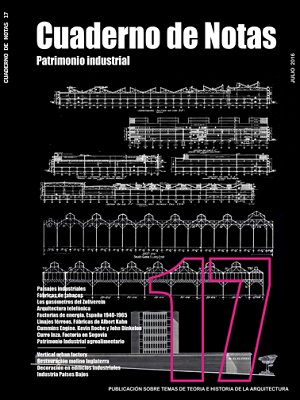Linajes férreos: uso tipológico de precedentes ferroviarios en Albert Kahn
DOI:
https://doi.org/10.20868/cn.2016.3483Palabras clave:
Albert Kahn, arquitectura industrial, arquitectura ferroviaria, puentes metálicos ferrocarril, Fordismo, naves de montaje, hangaresResumen
Los edificios industriales de la primera época de Kahn iniciaron un proceso sinérgico con los procesos de montaje, dependiendo cada vez más de la producción en cadena fordista, la cual puede homologarse, en su motricidad lineal, a la de un tren. Así, se llega a mostrar que las numerosas naves de montaje de vehículos para Ford o Packard son edificios de producción industrial y a la vez terminales de carga y descarga ferroviaria. Existió por tanto un interesante trasvase de elementos tipológicos de las construcciones ferroviarias a la arquitectura industrial de Kahn, lo cual se analiza a través de ejemplos característicos como las terminales, las freighthouses, las trainsheds, los depots o las enginehouses. El otro gran tipo constructivo de claro linaje ferroviario fueron los puentes metálicos norteamericanos, que a su vez fueron asimilados en las grandes estructuras de naves y hangares. Con ellos se aportaron soluciones a problemas de luces hasta entonces desconocidas, sugiriéndose un papel destacado, tanto aquí como en otros casos, en el empleo de voladizos.
Descargas
Referencias
Allison, Tim. 2014. Freight handling technologies and industrial building design: Freighthouse and warehouse facilities of the Chicago Junction Railway, 1900-30. Industrial Archaeology Review. 36, 2: 109,127.
Banham, Reyner. 1986. A Concrete Atlantis. U.S. Industrial Building and European Modern Architecture 1900-1925. Cambridge: The MIT Press.
Berg, Walter Gilman. 1893. Buildings and structures of American railroads: A reference book for railroad managers, superintendents, master mechanics, engineers, architects, and students. Nueva York: J. Wiley & sons.
Borie, Alain, Micheloni, Pierre y Pinon, Pierre. 1978.Forma y deformación. Barcelona: Reverté.
Bucci, Federico. 2002. Albert Kahn: Architect of Ford. Nueva York: Princeton Architectural Press.
Condit, Carl W. American Building Art. Vol 1. The Nineteenth Century. 1960. Nueva York. Oxford University Press.
Christen, Barbara S y Flanders, Steven. 2001. Cass Gilbert, Life and Work: Architect of the Public Domain. Nueva York. W.W. Norton And Company.
C. W. Hunt Company. 1893. Coal Handling machinery. Designed and manufactured by the C. H. Hunt Company. Nueva York. C. H. Hunt Company.
De la Torre Díaz, Francisco Javier. 2001. El modelo de diálogo intercultural de Alasdair MacIntyre. Madrid: Dykinson-Universidad San Pablo CEU. Ferry, W Hawkins. 1970. The legacy of Albert Kahn. Detroit: Wayne State University Press.
Foster, Wolcott C. 1908. A treatise on wooden trestle bridges according to the present practice on American railroads. Nueva York: J. Wiley & sons.
Giedion, Sigfried. 1970. Mechanization Takes Command: A Contribution to Anonymous History. New York: Oxford University Press.
Hildebrand, Grant. 1974. Designing for industry: the architecture of Albert Kahn. Cambridge: The MIT Press.
Hounshell, David A. 1984. From the American System to Mass Production. Baltimore: The Johns Hopkins University Press.
Hugel, G. C. 1938. Historical Sketch of Dearborn Station. Railway & Locomotive Historical Society Bulletin, No. 47. 46, 95.
Hyde, Charles K. 1996. Assembly-Line Architecture: Albert Kahn and the Evolution of the U.S. Auto Factory, 1905-1940. IA, The Journal of the Society for Industrial Archeology. V 22, N 2.
Kemp, Emory L. 2005. American Bridge Patents: The First Century, 1790-1890. Morgantown: West Virginia University Press.
Le Corbusier. 2006. Hacia una arquitectura. Barcelona: Ediciones Apostrofe.
Lee, Charles E. 1943. The evolution of railways. Londres: The Railway Gazette.
Macintyre, Alasdair. 1981. After virtue. A Study in Moral Theory. Notre Dame: University of Notre Dame Press.
Macintyre, Alasdair. 1988. Whose Justice? Wich Rationality?. Notre Dame: University of Notre Dame Press.
Marquis, Albert Nelson. 1914. The Book of Detroiters.
A Biographical Dictionary of Leading Living Men of the City of Detroit. Chicago: A. N. Marquis & Company.
Martí Arís, Carlos. 1993. Las variaciones de la identidad. Barcelona: Ediciones del Serbal C.O.A.C.
Meeks, Carrol L.V. 1995. The railroad station. An architectural history. Nueva York: Dover Publications.
Middleton, William D. 1999. Landmarks on the Iron Road. Two Centuries of North American Railroad Engineering. Bloomington: Indiana University Press.
Nelson, George. 1939. Industrial architecture of Albert Kahn inc. Nueva York: Architectural Book Publishing Company.
Nye, David E. 2013. America’s assembly line. Cambridge: MIT Press.
Schneider, Charles Conrad. 1885. The cantilever bridge at Niagara Falls. With discussion. Buffalo: American Society of Civil Engineers.
Simondon, Gilbert. 2008. El modo de existencia de los objetos técnicos. 1956. Buenos Aires: Editorial Prometeo.
VV. AA. 1889. The American railway; its construction, development, management, and appliances. Nueva York: C. Scribner's sons.
VV. AA. 1972. Albert Kahn: Architect abroad. Exhibition organized by the graduate seminar in museum practice. Catalogue. Ann Arbor: The University of Michigan Museum of Art.













